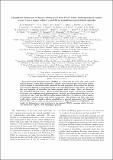Files in this item
Ubiquitous formation of bulk Dirac cones and topological surface states from a single orbital manifold in transition-metal dichalcogenides
Item metadata
| dc.contributor.author | Bahramy, M. S. | |
| dc.contributor.author | Clark, O. J. | |
| dc.contributor.author | Yang, B.-J. | |
| dc.contributor.author | Feng, J. | |
| dc.contributor.author | Bawden, L. | |
| dc.contributor.author | Riley, J. M. | |
| dc.contributor.author | Markovic, I. | |
| dc.contributor.author | Mazzola, F. | |
| dc.contributor.author | Sunko, V. | |
| dc.contributor.author | Biswas, D. | |
| dc.contributor.author | Cooil, S. P. | |
| dc.contributor.author | Jorge, M. | |
| dc.contributor.author | Wells, J. W. | |
| dc.contributor.author | Leandersson, M. | |
| dc.contributor.author | Balasubramanian, T. | |
| dc.contributor.author | Fujii, J. | |
| dc.contributor.author | Vobornik, I. | |
| dc.contributor.author | Rault, J. | |
| dc.contributor.author | Kim, T.K. | |
| dc.contributor.author | Hoesch, M. | |
| dc.contributor.author | Okawa, K. | |
| dc.contributor.author | Asakawa, M. | |
| dc.contributor.author | Sasagawa, T. | |
| dc.contributor.author | Eknapakul, T. | |
| dc.contributor.author | Meevasana, W. | |
| dc.contributor.author | King, P. D. C. | |
| dc.date.accessioned | 2018-05-27T23:33:31Z | |
| dc.date.available | 2018-05-27T23:33:31Z | |
| dc.date.issued | 2018-01 | |
| dc.identifier | 251399676 | |
| dc.identifier | 53b08fb4-b1ab-4ed6-b877-e5f668a462a3 | |
| dc.identifier | 85038602824 | |
| dc.identifier | 000422790000011 | |
| dc.identifier.citation | Bahramy , M S , Clark , O J , Yang , B-J , Feng , J , Bawden , L , Riley , J M , Markovic , I , Mazzola , F , Sunko , V , Biswas , D , Cooil , S P , Jorge , M , Wells , J W , Leandersson , M , Balasubramanian , T , Fujii , J , Vobornik , I , Rault , J , Kim , T K , Hoesch , M , Okawa , K , Asakawa , M , Sasagawa , T , Eknapakul , T , Meevasana , W & King , P D C 2018 , ' Ubiquitous formation of bulk Dirac cones and topological surface states from a single orbital manifold in transition-metal dichalcogenides ' , Nature Materials , vol. 17 , no. 1 , pp. 21-28 . https://doi.org/10.1038/nmat5031 | en |
| dc.identifier.issn | 1476-1122 | |
| dc.identifier.other | ORCID: /0000-0002-1631-9556/work/64698121 | |
| dc.identifier.uri | https://hdl.handle.net/10023/13552 | |
| dc.description | Funding: Leverhulme Trust, the Engineering and Physical Sciences Research Council, UK (Grant Nos. EP/M023427/1 and EP/I031014/1), the Royal Society, OJC, LB, JMR and VS acknowledge EPSRC for PhD studentship support through grant Nos. EP/K503162/1, EP/G03673X/1, EP/L505079/1, and EP/L015110/1. | en |
| dc.description.abstract | Transition-metal dichalcogenides (TMDs) are renowned for their rich and varied bulk properties, while their single-layer variants have become one of the most prominent examples of two-dimensional materials beyond graphene. Their disparate ground states largely depend on transition metal d-electron-derived electronic states, on which the vast majority of attention has been concentrated to date. Here, we focus on the chalcogen-derived states. From density-functional theory calculations together with spin- and angle-resolved photoemission, we find that these generically host a coexistence of type-I and type-II three-dimensional bulk Dirac fermions as well as ladders of topological surface states and surface resonances. We demonstrate how these naturally arise within a single p-orbital manifold as a general consequence of a trigonal crystal field, and as such can be expected across a large number of compounds. Already, we demonstrate their existence in six separate TMDs, opening routes to tune, and ultimately exploit, their topological physics. | |
| dc.format.extent | 8 | |
| dc.format.extent | 24309448 | |
| dc.language.iso | eng | |
| dc.relation.ispartof | Nature Materials | en |
| dc.subject | QC Physics | en |
| dc.subject | QD Chemistry | en |
| dc.subject | T Technology | en |
| dc.subject | DAS | en |
| dc.subject | BDC | en |
| dc.subject | R2C | en |
| dc.subject | ~DC~ | en |
| dc.subject.lcc | QC | en |
| dc.subject.lcc | QD | en |
| dc.subject.lcc | T | en |
| dc.title | Ubiquitous formation of bulk Dirac cones and topological surface states from a single orbital manifold in transition-metal dichalcogenides | en |
| dc.type | Journal article | en |
| dc.contributor.sponsor | The Leverhulme Trust | en |
| dc.contributor.sponsor | The Leverhulme Trust | en |
| dc.contributor.sponsor | EPSRC | en |
| dc.contributor.sponsor | EPSRC | en |
| dc.contributor.sponsor | The Royal Society | en |
| dc.contributor.institution | University of St Andrews. School of Physics and Astronomy | en |
| dc.contributor.institution | University of St Andrews. Condensed Matter Physics | en |
| dc.identifier.doi | 10.1038/nmat5031 | |
| dc.description.status | Peer reviewed | en |
| dc.date.embargoedUntil | 2018-05-27 | |
| dc.identifier.grantnumber | PLP-2015-144 | en |
| dc.identifier.grantnumber | 2016-006 | en |
| dc.identifier.grantnumber | EP/M023427/1 | en |
| dc.identifier.grantnumber | EP/I031014/1 | en |
| dc.identifier.grantnumber | UF120096 | en |
This item appears in the following Collection(s)
Items in the St Andrews Research Repository are protected by copyright, with all rights reserved, unless otherwise indicated.

